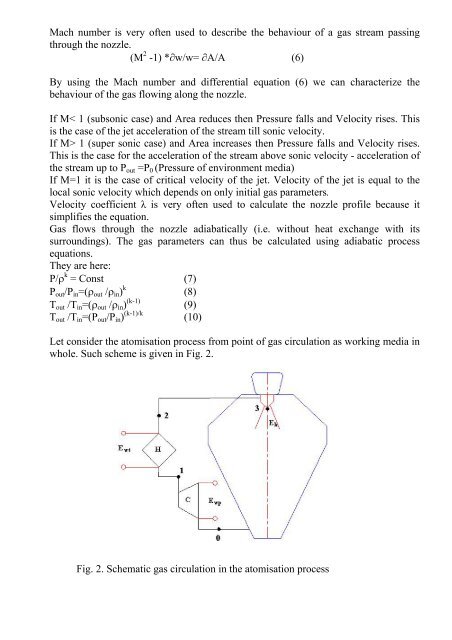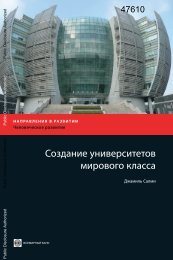THEORETICAL ADVANTAGES OF HOT GAS ATOMIZATION OF ...
THEORETICAL ADVANTAGES OF HOT GAS ATOMIZATION OF ...
THEORETICAL ADVANTAGES OF HOT GAS ATOMIZATION OF ...
You also want an ePaper? Increase the reach of your titles
YUMPU automatically turns print PDFs into web optimized ePapers that Google loves.
Mach number is very often used to describe the behaviour of a gas stream passing<br />
through the nozzle.<br />
(M 2 -1) *w/w= A/A (6)<br />
By using the Mach number and differential equation (6) we can characterize the<br />
behaviour of the gas flowing along the nozzle.<br />
If M< 1 (subsonic case) and Area reduces then Pressure falls and Velocity rises. This<br />
is the case of the jet acceleration of the stream till sonic velocity.<br />
If M> 1 (super sonic case) and Area increases then Pressure falls and Velocity rises.<br />
This is the case for the acceleration of the stream above sonic velocity - acceleration of<br />
the stream up to P out =P 0 (Pressure of environment media)<br />
If M=1 it is the case of critical velocity of the jet. Velocity of the jet is equal to the<br />
local sonic velocity which depends on only initial gas parameters.<br />
Velocity coefficient λ is very often used to calculate the nozzle profile because it<br />
simplifies the equation.<br />
Gas flows through the nozzle adiabatically (i.e. without heat exchange with its<br />
surroundings). The gas parameters can thus be calculated using adiabatic process<br />
equations.<br />
They are here:<br />
P/ k = Const (7)<br />
P out /P in =( out / in ) k (8)<br />
T out /T in =( out / in ) (k-1) (9)<br />
T out /T in =(P out /P in ) (k-1)/k (10)<br />
Let consider the atomisation process from point of gas circulation as working media in<br />
whole. Such scheme is given in Fig. 2.<br />
Fig. 2. Schematic gas circulation in the atomisation process







